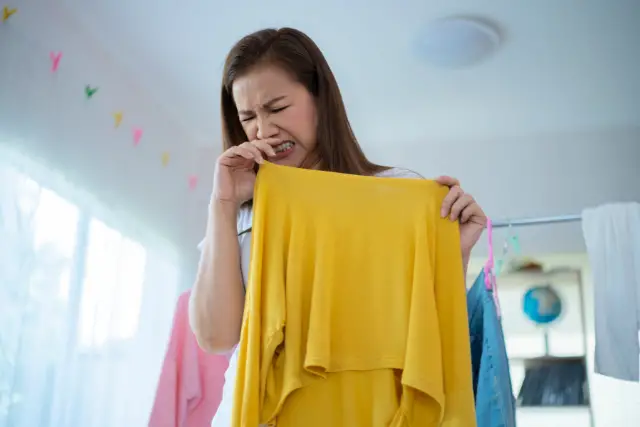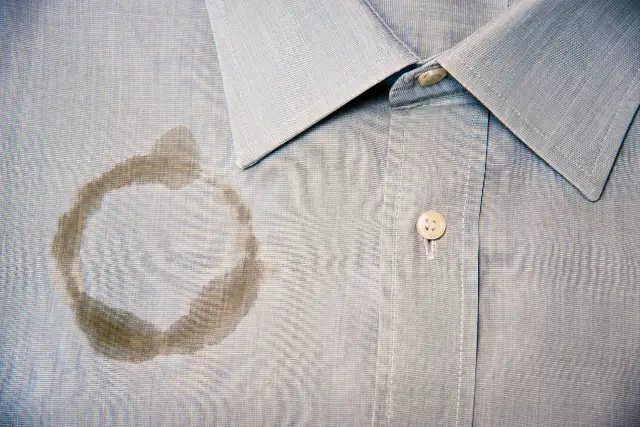Nonenal odor, which is commonly associated with aging, can leave a stubborn scent on clothing. Regular laundry detergents struggle to remove this type of odor.
If you’re noticing a persistent musty smell on your fabrics despite regular washing, you’re likely dealing with nonenal. Understanding how to remove nonenal odor from clothes effectively requires specific strategies that go beyond your usual laundry routine.
Key Takeaways
- Implement specialized washing methods to target nonenal odor in clothing.
- Use natural deodorizers to neutralize persistent odors in fabrics.
- Apply preventive measures to minimize the recurrence of nonenal odor in clothes.
What is Nonenal Odor?
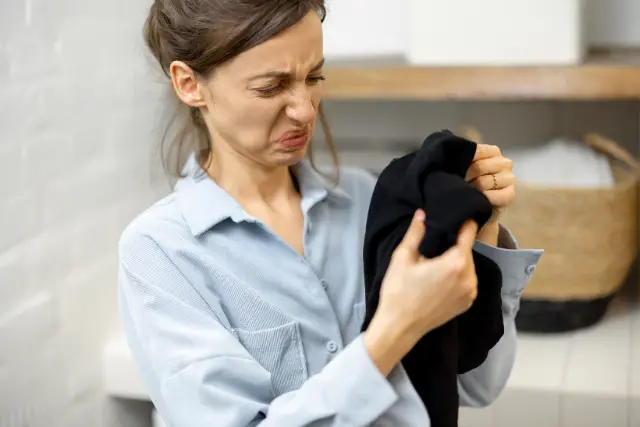
Nonenal is a chemical compound that typically appears with age and is often responsible for a specific type of body odor. This odor is common among elderly individuals, starting around the age of 40. It is distinct from the body odor associated with youth and is more resistant to typical personal hygiene practices.
Dealing with this type of body odor in fabrics can be particularly challenging. Nonenal clings to fibers and can withstand typical washing temperatures and detergents. However, with the right techniques and products, you can tackle nonenal and restore freshness to your garments. This involves a combination of thorough washing methods, natural deodorizing agents, and preventive practices.
Production of Nonenal:
- Aging: As you age, your skin’s antioxidant defenses weaken, leading to an increase in the breakdown of omega-7 unsaturated fatty acids.
- Bacteria: The breakdown by bacteria on your skin produces nonenal, especially after perspiration.
- Body Oils and Sweat: Nonenal formation is linked to sweat and body oils, as these are the substances that bacteria act upon.
Nonenal and Fabrics:
- Retention: Nonenal can cling to fabrics, making the odor linger on clothes even after washing.
- Challenges: Regular detergents may not effectively neutralize nonenal due to their lipid-based chemical structure.
Influence of Hygiene:
- Maintaining good hygiene can help manage nonenal production but may not completely prevent the presence of nonenal odor.
By understanding the factors contributing to nonenal odor, you can better approach the removal process from clothing and textiles.
Effective Washing Techniques

For success in removing nonenal odor from your clothing, the correct use of laundry detergent, water temperature, and washing machine settings is crucial.
Using the Right Laundry Detergent
When tackling nonenal, choosing a high-quality laundry detergent is essential. Detergents like Persil are specifically designed for odors and can work effectively in both standard and HE machines. Avoid using too much detergent, as this can leave residue. A general guideline is to use:
- HE Machine: 2 tablespoons of Persil
- Standard Machine: 1/4 cup of Persil
Optimal Water Temperatures
Water temperature is a vital factor in the washing process:
- Cold Water: Best for delicate items. However, it may not be as effective at removing nonenal on its own.
- Hot Water: More effective at eliminating nonenal odor but can cause shrinkage or color fading with certain fabrics.
Always check the care label on your clothing for the recommended water temperature. Use a thermometer to verify water temperature if your washing machine doesn’t display it.
Washing Machine Settings
Proper machine settings enhance the effectiveness of detergent and water temperature in eliminating odors:
- Cycle Selection: Choose a cycle with a pre-soak option if available, as this can help in breaking down the nonenal before the main wash.
- Load Size: Do not overfill your machine. Clothes should move freely.
Ensure you’re utilizing the correct settings on your washing machine. A prolonged wash cycle with a high agitation level can help remove stubborn odors. For HE machines, use the ‘heavy-duty’ cycle when necessary, and for standard machines, select the longest cycle available.
Natural Deodorizing Agents
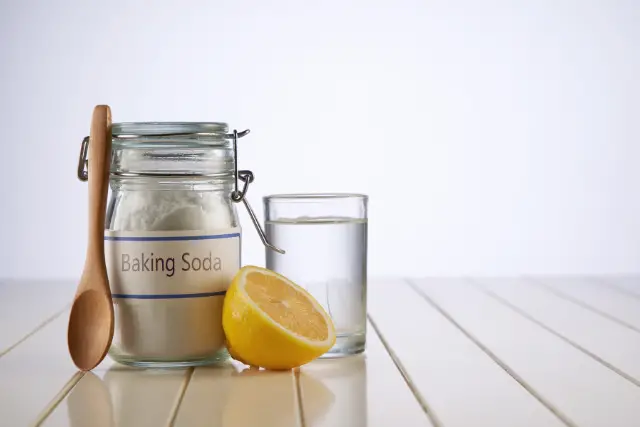
Natural deodorizing agents can effectively neutralize nonenal odor from your clothes using readily available household items. These methods leverage the odor-absorbing and antibacterial properties of natural substances.
Baking Soda Solutions
Create a baking soda solution by mixing one part baking soda with four parts water. Soak your clothes in the mixture for at least one hour. Baking soda, a natural odor absorber, helps to pull the nonenal odor from the fabric. After soaking, wash as usual and air dry in sunlight for best results, as the air and sunlight will further aid in breaking down the odor.
Vinegar Treatments
Utilize white vinegar by adding half a cup to your wash cycle in place of fabric softener. The vinegar solution works to break down the nonenal odor without damaging your clothes. Moreover, the smell of vinegar will dissipate quickly, especially if the garments are left to dry in fresh air.
Use of Persimmon Extract
Incorporate persimmon extract into your laundry routine to combat nonenal odor. This traditional Japanese remedy has been shown to effectively eliminate difficult odors. Add a teaspoon of persimmon extract to your laundry detergent and wash as normal. Not only does it attack the odor itself, but it also leaves behind a subtle, fresh scent.
Additional Tips for Odor Prevention
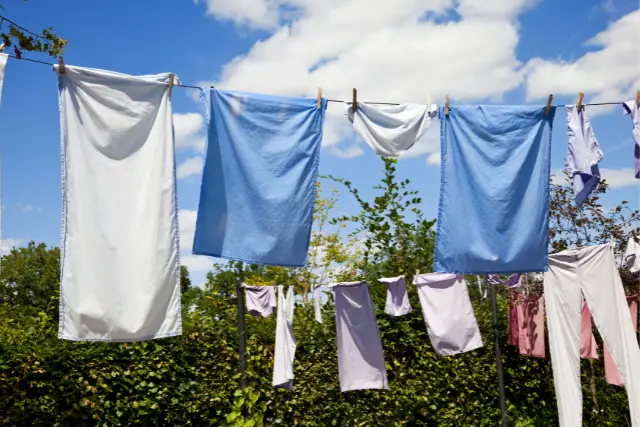
When it comes to preventing nonenal and other odors from lingering on your clothes, follow these guidelines for effective management:
Ventilation: Ensure proper airflow in your laundry area. If possible, hang clothes in an area with good ventilation before storing them away.
Air Dry: Whenever feasible, opt for air drying. Outdoor air drying can help dissipate odors naturally, as sunshine has a mild bleaching and disinfecting effect on fabrics.
Prevent Accumulation: Avoid leaving sweaty clothes piled up. Hang them to dry if you’re unable to wash them immediately, as this prevents odor-causing bacteria from multiplying.
Fabric Care: Always check the care label on your garments. Some fabrics may require specific cleaning methods to avoid trapping odors.
Fabric Softener and Dryer Sheets: Use these products judiciously as they can leave a residue that traps odors. In some cases, skipping fabric softener and opting for vinegar in the wash can help neutralize smells.
Deodorant: Choose deodorants that are less likely to build up on your clothes. Wash areas with deodorant residue promptly to prevent the accumulation of odor-causing substances.
Enzymatic Cleaners: For stubborn odors, consider using enzymatic cleaners. These can break down odor-causing compounds at a molecular level.
Deodorizing: Incorporate natural deodorizing agents, like baking soda or activated charcoal, in your laundry routine. Add these directly to your washing machine to help absorb and neutralize odors.
Frequently Asked Questions
When dealing with nonenal odor, which is a body odor that typically becomes more prominent with age, there are several effective methods to eliminate it from fabrics. The following subsections address natural and household remedies, as well as preventative measures to combat this distinct smell.
Which natural remedies are useful in eliminating nonenal odor from fabrics?
Vinegar and baking soda are two natural substances that can break down nonenal odor. Soaking clothes in a solution of water and white vinegar, or adding a half cup of baking soda to the wash, can help in removing the odor from your clothing.
What household products can neutralize nonenal odor in textiles?
Household products such as borax and hydrogen peroxide are effective in neutralizing nonenal odors. Adding these to your usual laundry cycle can help in deodorizing textiles. Be sure to follow the instructions on the packaging for the best results.
How can you get rid of nonenal odor from furnishings and clothes?
To remove nonenal odor from clothing and furnishings, wash the clothes with detergents containing persimmon extract or use specialty laundry additives designed for odor removal. For furnishings, consider using upholstery cleaners with enzymes that target odors or spraying with a diluted vinegar solution and then airing out.
What steps can be taken to prevent nonenal smell from persisting in clothing?
To prevent nonenal odor from becoming embedded in your clothing, wash them promptly after wearing. Also, avoid allowing sweat-soaked clothes to sit in the laundry hamper.
Additionally, ensure your clothes dry completely before storing them to prevent mildew growth. Mildew can exacerbate odors.
